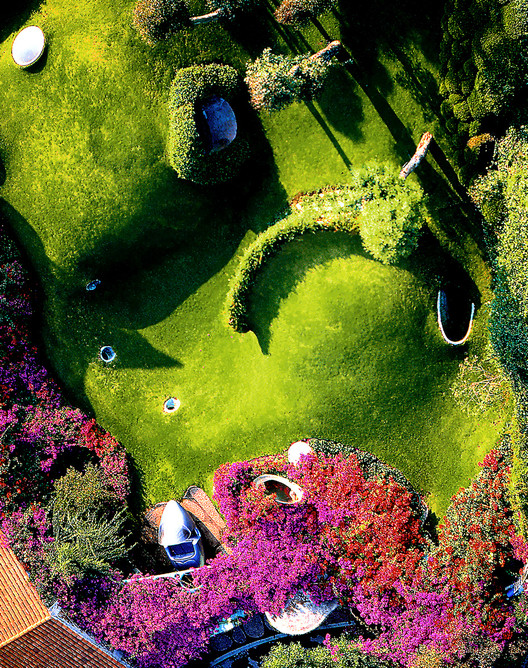Nogunri Peace Museum METAA
2014-12-03 01:00
© Jaekyung Kim
c.Jaekyung Kim


架构师提供的文本描述。怎么看?
Text description provided by the architects. How to see it?
150人死亡。13人失踪,55人受伤,残疾。那是在1950年7月26日至29日。然而,这是不正确的数字。更多的人在隧道里被惊吓了三天。然后划分他们的生死存亡。半个世纪过去了。没人谈论责任。找不到真相。事件发生了,但找不到线索。数千名死者家属不得不在没有祖传石碑的情况下举行祖传仪式。经过无止境的努力,真相永远无法重建。同时,它甚至被隐藏起来。
150 people were dead. 13 people were missed and 55 people were injured and got a disability. It was in 1950 26 to 29 of july. However, that is incorrect number. Even more people were terrified in the tunnel over three days. Then divided their life and death. Half of a century passed. Nobody talked about responsibility. Can not find the truth. Incident happened but nowhere could find the clue. Thousand of the bereaved families had to perform an ancestral rites without an ancestral tablet. With all the endless efforts, the truth never reconstructed. Meanwhile, it is even concealed.
© Jaekyung Kim
c.Jaekyung Kim


人们说那是一场战争的悲剧或偶发的案件。它试图与其他案件和解。然而,每一份证词都陈述了案情。这起Nogunri案并不是一个小事件,不能埋葬在一场被称为战争的巨大悲剧中。宣布了一项特殊的法律和纪念仪式的事务正在进行中,但真相尚未揭晓。尽管如此,Nogunri案的某些部分仍被报道为一段历史。关于主题和谈论和平的对象仍然不确定。只有受害者害怕,失去亲人的家庭痛苦依然明显。
People said that is a tragedy of war or incidental case. It was tried to pacified with other cases. However every single testimonies stated the case. This nogunri case is not a small incident that can not buried in a huge tragedy called a war. Proclaimed a special law and memorial ceremony business is in a progress but the truth has not come yet. Still some part of the nogunri case are covered to be told as a history. Still uncertain about the subject and the object to talk about peace. Only the victims fear and the bereaved families pain remained clearly.
Master Plan


公用存储器
Communal memory
只是因为对死者家属的记忆,这起案件才出现在公众面前。他们的活动在那里。正是由于这些活动,历史陈述的一部分才被揭露出来。这起案件不可能是历史,即使有这么多的证据。
It was only because of the memory of the bereaved families that this nogunri case is appeared to the public. Their activities were there. Only because of that activities the part of the historical statements are exposed. This nogunri case can not be a history even that has this much of proofs.
© Jaekyung Kim
c.Jaekyung Kim


我们经历过的一些活动属于自传体记忆。历史记忆是只有通过历史记录才能学到的。然而,诺古特里的记忆对我们来说仍然是一段活跃的历史。因此,建构我们的身份是集体记忆过程的一部分。
Some activities that we were through is belong to autobiographical memory. Historical memory is only can be learned by the historical record. However nogunri's memory is still an active-history to us. Therefore it is a part of process of communal memory to construct our identity.
© Jaekyung Kim
c.Jaekyung Kim


然而,在公共记忆的过程中,事件中的欲望之间存在着紧张关系。政府、受害者和死者家属以及观察者的愿望。有一种张力是由一种普遍的社会记忆、一种生活的自传体记忆和一种对人类的说教记忆所构成的。在这个地方,谈论“历史”或“和平”的公园是不稳定的。
However, in a process of communal memory, a tension is circumstanced between the desires in the incident. Desires from the government, from the victims and the bereaved families, and from the observers. There is a tension that is made up by an universal-social memory, by an autobiographical memory of a life, and by a didactic memory for humankind. A park talking about 'history' or 'peace' is not stable in this place where still does not solved about this tension.
© Jaekyung Kim
c.Jaekyung Kim


此外,博物馆在谈论“历史”或“和平”时,也不可避免地会从这个地方的空虚开始。从空虚开始的体系结构是一种正在观察进入公共记忆的过程的体系结构。
In addition, a museum talking about 'history' or 'peace' can not avoid to start with emptiness in this place. An architecture start with emptiness is an architecture that is watching the process that is going to communal memory.


反记忆
Anti-memory
反对官方历史的记忆叫做“反记忆”。反记忆是每个人的活动和支离破碎的记忆,它是一种试图干预一些将要制度化的记忆。这是一种记忆,试图通过轻率建造的纪念碑和纪念符号来揭示官方记忆的光环。
A memory against the official history is called 'anti-memory'. Anti-memory is activities of every single persons and fragmented memory, and it is a memory trying intervene in some memories that is going to be institutionalized. It is a memory that is trying reveal an aura of an official memory by rashly built monument and memorial symbols.
© Jaekyung Kim
c.Jaekyung Kim


从人的经验是重要的建立‘反记忆’。尤其是他们身上印上的经验是非常重要的。当他们体验到那种记忆时,他们现在所感受到的空间比他们的视觉更重要。
Experiences from people are important to build an 'anti-memory'. Especially the experiences that is stamped on their body is very important. The spatiality that they felt at the moment is more important then their sight when they experiences that kinds of memory.
Floor Plan


Nogunri案件的共同记忆过程是渐进的。这个历史与和平的博物馆,只能告诉我们真相的真相,却不能为某个人宣称整个历史或和平。它只是想拖延一些想要被及时正式化的历史。历史与和平博物馆必须观察当前公共记忆的进步过程,它希望成为“反记忆”的建筑。这是想要干预游客的身体作为一个空间。并希望成为一种建筑,通过积累他们的经验来询问我们的身份。
A process of communal memory of nogunri case is present progressive. This museum of history and peace, only can inform the revealed truth, but cant claim the whole history or the peace for somebody. It is just want to delay some history that wants to be made official in time. The museum of history and peace that has to observe the present progressive process of communal memory want to be an architecture of 'anti-memory'. This wants to intervene into visitor's body as a space. And wants to be an architecture asking our identity by accumulate experiences of them.
© Jaekyung Kim
c.Jaekyung Kim


思考与调整
Consideration and readjustment
博物馆、纪念毛巾和事故现场(双子隧道周围)在地点和语义上都有着密切的关系。但是,在给定的条件下,即原方案很难接近三要素之间事件的潜在意义。在考虑网站作为一个真正有经验的地方游客之前,我们建议首先调整网站。博物馆将成为这一风景的一部分。
Museum, memorial towel and the scene of incident (around the twin tunnel) are in a close relationship locationally and semantically. However, the given condition, in other words, the original scheme has difficulty to approach to potential meaning of the incident between three elements. Before considerate the site as a place that will be really experienced by visitors, we suggest readjustment the site first. The museum will be a part of this scenery.
© Jaekyung Kim
c.Jaekyung Kim






























































Architects METAA
Location Yeongdong-gun, Chungcheongbuk-do, South Korea
Category Exhibition Center
Architect in Charge Jongho Yi, Euijung Woo
Area 1892.0 sqm
Project Year 2011
Photographs Jaekyung Kim
























